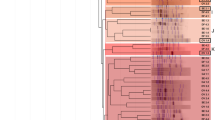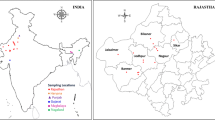Abstract
Acacia senegal and Acacia seyal are small, deciduous legume trees, most highly valued for nitrogen fixation and for the production of gum arabic, a commodity of international trade since ancient times. Symbiotic nitrogen fixation by legumes represents the main natural input of atmospheric N2 into ecosystems which may ultimately benefit all organisms. We analyzed the nod and nif symbiotic genes and symbiotic properties of root-nodulating bacteria isolated from A. senegal and A. seyal in Senegal. The symbiotic genes of rhizobial strains from the two Acacia species were closed to those of Mesorhizobium plurifarium and grouped separately in the phylogenetic trees. Phylogeny of rhizobial nitrogen fixation gene nifH was similar to those of nodulation genes (nodA and nodC). All A. senegal rhizobial strains showed identical nodA, nodC, and nifH gene sequences. By contrast, A. seyal rhizobial strains exhibited different symbiotic gene sequences. Efficiency tests demonstrated that inoculation of both Acacia species significantly affected nodulation, total dry weight, acetylene reduction activity (ARA), and specific acetylene reduction activity (SARA) of plants. However, these cross-inoculation tests did not show any specificity of Mesorhizobium strains toward a given Acacia host species in terms of infectivity and efficiency as stated by principal component analysis (PCA). This study demonstrates that large-scale inoculation of A. senegal and A. seyal in the framework of reafforestation programs requires a preliminary step of rhizobial strain selection for both Acacia species.




Similar content being viewed by others
Abbreviations
- NFT:
-
Nitrogen-fixing trees
References
Sprent J (1994) Evolution and diversity in the legume-rhizobium symbiosis: chaos theory? Plant Soil 161:1–10. doi:10.1007/bf02183080
Kang BT, Grimme H, Lawson TT (1985) Alley cropping sequentially cropped maize and cowpea with leucaena on sandy soil in Southern Nigeria. Plant Soil 85:267–277
Midgley JJ, Bond WJ (2001) A synthesis of the demography of African acacias. J Trop Ecol 17:871–886
Wickens GE, Seif El Din AG, Guinko S, Nahal I (1995) Role of Acacia species in the rural economy of dry Africa and the Near East. In: 13 col. Phot., FRDF (ed) Rome. pp 134
Njiti CF, Galiana A (1996) Symbiotic properties and rhizobium requirements for effective nodulation of five tropical dry zone Acacias. Agroforest Syst 43:265–275
Motlagh S, Ravines P, Karamallah KA, Qifeng M (2006) The analysis of Acacia gums using electrophoresis. Food Hydrocolloid 20:848–854
Al-Assaf S, Phillips GO, Aoki H, Sasaki Y (2007) Characterization and properties of Acacia senegal (L.) Willd. var. senegal with enhanced properties (Acacia (sen) SUPER GUMTM): part 1. Controlled maturation of Acacia senegal var. senegal to increase viscoelasticity, produce a hydrogel form and convert a poor into a good emulsifier. Food Hydrocolloid 21:319–328
Perret X, Staehelin C, Broughton WJ (2000) Molecular basis of symbiotic promiscuity. Microbiol Mol Biol Rev 64:180–201
Laguerre G, Nour SM, Macheret V, Sanjuan J, Drouin P, Amarger N (2001) Classification of rhizobia based on nodC and nifH gene analysis reveals a close phylogenetic relationship among Phaseolus vulgaris symbionts. Microbiology 147:981–993
Rivas R, Laranjo M, Mateos PF, Oliveira S, Martinez-Molina E, Velazquez E (2007) Strains of Mesorhizobium amorphae and Mesorhizobium tianshanense, carrying symbiotic genes of common chickpea endosymbiotic species, constitute a novel biovar (ciceri) capable of nodulating Cicer arietinum. Lett Appl Microbiol 44:412–418. doi:10.1111/j.1472-765X.2006.02086.x
Hennecke H, Kaluza K, Thony B, Fuhrmann M, Ludwig W, Stackebrandt E (1985) Concurrent evolution of nitrogenase genes and 16S rRNA in Rhizobium species and other nitrogen fixing bacteria. Arch Microbiol 142:342–348
Ueda T, Suga Y, Yahiro N, Matsuguchi T (1995) Phylogeny of Sym plasmids of rhizobia by PCR-based sequencing of a nodC segment. J Bacteriol 177:468–472
Diouf D, Fall D, Chaintreuil C, Ba AT, Dreyfus B, Neyra M, Ndoye I, Moulin L (2010) Phylogenetic analyses of symbiotic genes and characterization of functional traits of Mesorhizobium spp. strains associated with the promiscuous species Acacia seyal Del. J Appl Microbiol 108:818–830. doi:10.1111/j.1365-2672.2009.04500.x
Sarr A, Neyra M, Houeibib MA, Ndoye I, Oihabi A, Lesueur D (2005) Rhizobial populations in soils from natural Acacia senegal and Acacia nilotica forests in Mauritania and the Senegal river valley. Microb Ecol 50:152–162
Fall D, Diouf D, Ourarhi M, Faye A, Abdelmounen H, Neyra M, Sylla SN, Missbah El Idrissi M (2008) Phenotypic and genotypic characteristics of Acacia senegal (L.) Willd. root-nodulating bacteria isolated from soils in the dryland part of Senegal. Lett Appl Microbiol 47:85–97. doi:10.1111/j.1472-765X.2008.02389.x
Diouf D, Samba-Mbaye R, Lesueur D, Ba AT, Dreyfus B, de Lajudie P, Neyra M (2007) Genetic diversity of Acacia seyal Del. rhizobial populations indigenous to Senegalese soils in relation to salinity and pH of the sampling sites. Microb Ecol 54:553–566. doi:10.1007/s00248-007-9243-0
Ndoye I, Gueye M, Danso SKA, Dreyfus B (1995) Nitrogen fixation in Faidherbia albida, Acacia raddiana, Acacia senegal and Acacia seyal estimated using the 15N isotope dilution technique. Plant Soil 172:175–180
Bakhoum N, Le Roux C, Diouf D, Kane A, Ndoye F, Fall D, Duponnois R, Noba K, Sylla SN, Galiana A (2014) Distribution and diversity of Rhizobial populations associated with Acacia senegal (L.) Willd. Provenances in Senegalese Arid and Semiarid Regions. Open J Forest 4:136–143. doi:10.4236/ojf.2014.42019
Sy A, Giraud E, Jourand P, Garcia N, Willems A, de Lajudie P, Prin Y, Neyra M, Gillis M, Boivin-Masson C, Dreyfus B (2001) Methylotrophic Methylobacterium bacteria nodulate and fix nitrogen in symbiosis with legumes. J Bacteriol 183:214–220
Sarita S, Sharma PK, Priefer UB, Prell J (2005) Direct amplification of rhizobial nodC sequences from soil total DNA and comparison to nodC diversity of root nodule isolates. FEMS Microbiol Ecol 54:1–11
Laguerre G, Allard MR, Revoy F, Amarger N (1994) Rapid identification of Rhizobia by restriction fragment length polymorphism analysis of PCR-amplified 16S rRNA genes. Appl Environ Microbiol 60:56–63
Widmer F, Shaffer BT, Porteous LA, Seidler RJ (1999) Analysis of nifH gene pool complexity in soil and litter at a Douglas fir forest site in the Oregon cascade mountain range. Appl Environ Microbiol 65:374–380
Altschul SF, Madden TL, Schaffer AA, Zhang J, Zhang Z, Miller W, Lipman DJ (1997) Gapped BLAST and PSI-BLAST: a new generation of protein database search programs. Nucleic Acids Res 25:3389–3402
Thompson JD, Gibson TJ, Plewniak F, Jeanmougin F, Higgins DG (1997) The CLUSTAL_X windows interface: flexible strategies for multiple sequence alignment aided by quality analysis tools. Nucleic Acids Res 25:4876–4882
Nicholas KB, Nicholas HJ, Deerfield DWI (1997) Genedoc: analysis and visualization of genetic variation. EMB News 4:14
Tamura K, Peterson D, Peterson N, Stecher G, Nei M, Kumar S (2011) MEGA5: molecular evolutionary genetics analysis using maximum likelihood, evolutionary distance, and maximum parsimony methods. Mol Biol Evol 28:2731–2739. doi:10.1093/molbev/msr121
Felsenstein J (1985) Confidence limits on phylogenies: an approach using the bootstrap. Evolution 39:783–791
Bakhoum N, Ndoye F, Kane A, Assigbetse K, Fall D, Sylla SN, Noba K, Diouf D (2012) Impact of rhizobial inoculation on Acacia senegal (L.) Willd. growth in greenhouse and soil functioning in relation to seed provenance and soil origin. World J Microbiol Biotechnol 28:2567–2579. doi:10.1007/s11274-012-1066-6
Hardy RWF, Holsten RD, Jackson EK, Burns RC (1968) The acetylene ethylene assay for N2 fixation: laboratory and field evaluation. Plant Physiol 43:185–207
Zhang JJ, Liu TY, Chen WF, Wang ET, Sui XH, Zhang XX, Li Y, Chen WX (2012) Mesorhizobium muleiense sp. nov., nodulating with Cicer arietinum L. in Xinjiang, China. Int J Syst Evol Microbiol 6:6
Degefu T, Wolde-meskel E, Frostegard A (2011) Multilocus sequence analyses reveal several unnamed Mesorhizobium genospecies nodulating Acacia species and Sesbania sesban trees in Southern regions of Ethiopia. Syst Appl Microbiol 34:216–226
Dobert RC, Breil BT, Triplett EW (1994) DNA sequence of the common nodulation genes of Bradyrhizobium elkanii and their phylogenetic relationship to those of other nodulating bacteria. Mol Plant Microbe Interact 7:564–572
Laranjo M, Alexandre A, Rivas R, Velazquez E, Young JP, Oliveira S (2008) Chickpea rhizobia symbiosis genes are highly conserved across multiple Mesorhizobium species. FEMS Microbiol Ecol 66:391–400
Wernegreen JJ, Riley MA (1999) Comparison of the evolutionary dynamics of symbiotic and housekeeping loci: a case for the genetic coherence of rhizobial lineages. Mol Biol Evol 16:98–113
Lan R, Reeves PR (2000) Intraspecies variation in bacterial genomes: the need for a species genome concept. Trends Microbiol 8:396–401
Mergaert P, Van Montagu M, Holsters M (1997) Molecular mechanisms of Nod factor diversity. Mol Microbiol 25:811–817
Suominen L, Roos C, Lortet G, Paulin L, Lindstrom K (2001) Identification and structure of the Rhizobium galegae common nodulation genes: evidence for horizontal gene transfer. Mol Biol Evol 18:907–916
Laranjo M, Young JP, Oliveira S (2012) Multilocus sequence analysis reveals multiple symbiovars within Mesorhizobium species. Syst Appl Microbiol 35:359–367
Moulin L, Bena G, Boivin-Masson C, Stepkowski T (2004) Phylogenetic analyses of symbiotic nodulation genes support vertical and lateral gene co-transfer within the Bradyrhizobium genus. Mol Phylogenet Evol 30:720–732
Barcellos FG, Menna P, da Silva Batista JS, Hungria M (2007) Evidence of horizontal transfer of symbiotic genes from a Bradyrhizobium japonicum inoculant strain to indigenous diazotrophs Sinorhizobium (Ensifer) fredii and Bradyrhizobium elkanii in a Brazilian Savannah soil. Appl Environ Microbiol 73:2635–2643. doi:10.1128/AEM.01823-06
Vinuesa P, Leon-Barrios M, Silva C, Willems A, Jarabo-Lorenzo A, Perez-Galdona R, Werner D, Martinez-Romero E (2005) Bradyrhizobium canariense sp. nov., an acid-tolerant endosymbiont that nodulates endemic genistoid legumes (Papilionoideae: Genisteae) from the Canary Islands, along with Bradyrhizobium japonicum bv. genistearum, Bradyrhizobium genospecies alpha and Bradyrhizobium genospecies beta. Int J Syst Evol Microbiol 55:569–575. doi:10.1099/ijs.0.63292-0
Wang H, Man CX, Wang ET, Chen WX (2009) Diversity of rhizobia and interactions among the host legumes and rhizobial genotypes in an agricultural-forestry ecosystem. Plant Soil 314:169–182
Alexandre A, Brigido C, Laranjo M, Rodrigues S, Oliveira S (2009) Survey of Chickpea Rhizobia diversity in Portugal reveals the predominance of species distinct from Mesorhizobium ciceri and Mesorhizobium mediterraneum. Microb Ecol 58:930–941. doi:10.1007/s00248-009-9536-6
Kalita M, Stepkowski T, Lotocka B, Malek W (2006) Phylogeny of nodulation genes and symbiotic properties of Genista tinctoria bradyrhizobia. Arch Microbiol 186:87–97
Rogel MA, Ormeno-Orrillo E, Martinez Romero E (2011) Symbiovars in rhizobia reflect bacterial adaptation to legumes. Syst Appl Microbiol 34:96–104
Faghire M, Mandri B, Oufdou K, Bargaz A, Ghoulam C, Ramirez-Bahena MH, Velazquez E, Peix A (2012) Identification at the species and symbiovar levels of strains nodulating Phaseolus vulgaris in saline soils of the Marrakech region (Morocco) and analysis of the otsA gene putatively involved in osmotolerance. Syst Appl Microbiol 35:156–164
Dreyfus BL, Diem HG, Freire J, Keya SO, Dommergues YR (1987) Nitrogen fixation in tropical agriculture and forestry. In: E, JD, Dommergues YR, Nyns EJ, Ratleedge C (eds) Microbial Technology in the developing World. Oxford University Press, Oxford, New York, Toronto, pp 7–50
Pueppke SG, Broughton WJ (1999) Rhizobium sp. strain NGR234 and R. fredii USDA257 share exceptionally broad, nested host ranges. Mol Plant Microbe Interact 12:293–318. doi:10.1094/MPMI.1999.12.4.293
Leon-Barrios M, Lorite MJ, Donate-Correa J, Sanjuan J (2009) Ensifer meliloti bv. lancerottense establishes nitrogen-fixing symbiosis with Lotus endemic to the Canary Islands and shows distinctive symbiotic genotypes and host range. Syst Appl Microbiol 32:413–420
Andrade DS, Murphy PJ, Giller KE (2002) The diversity of Phaseolus-nodulating rhizobial populations is altered by liming of acid soils planted with Phaseolus vulgaris L. in Brazil. Appl Environ Microbiol 68:4025–4034
Bala A, Giller KE (2007) Relationships between rhizobial diversity and host legume nodulation and nitrogen fixation in tropical ecosystems. Nutr Cycl Agroecosys 76:2–3
Acknowledgments
This work was financially supported by ACACIAGUM INCO STREP Contract Number 032233 and by a grant for N. BAKHOUM from the SCAC (Service de Cooperation et d’Action Culturelle) of France Embassy in Senegal.
Author information
Authors and Affiliations
Corresponding author
Rights and permissions
About this article
Cite this article
Bakhoum, N., Galiana, A., Le Roux, C. et al. Phylogeny of Nodulation Genes and Symbiotic Diversity of Acacia senegal (L.) Willd. and A. seyal (Del.) Mesorhizobium Strains from Different Regions of Senegal. Microb Ecol 69, 641–651 (2015). https://doi.org/10.1007/s00248-014-0507-1
Received:
Accepted:
Published:
Issue Date:
DOI: https://doi.org/10.1007/s00248-014-0507-1




